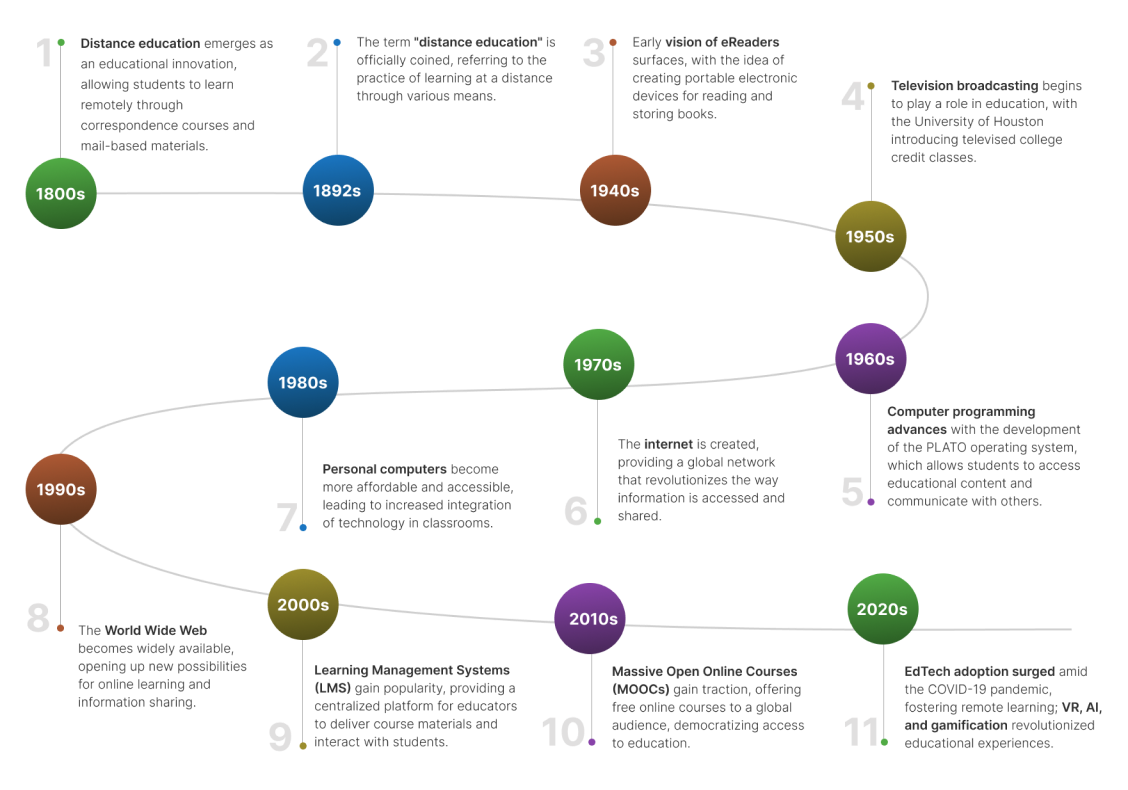Tech-Driven Transformations in Education

The educational technology (EdTech) industry is proliferating due to ongoing innovation. These innovations are reshaping the education landscape, making it better equipped to teach future generations.
This is done with the help of online tools like e-courses, virtual classrooms, webinars,
training videos, interactive modules, and digital assessments so that students can study at their convenience
from any location with an internet connection and at their own pace.
EdTech is having a profound effect because it rapidly lowers entry barriers. Previously, only those of higher
social standing could afford to send their children to conventional schools. Professionals in the field
constantly work to improve the educational system by creating new and exciting features, tools, and resources.
The advancement of video conferencing software and multimedia resources has increased the accessibility and
efficacy of EdTech. Blockchain-based grading tools and EdTech "robots" that students can use to take notes and
assess student work are current developments in the industry.
The term "EdTech" may come up in a conversation with a school administrator if you inquire about the use of
technology in the workplace. Scheduling events, coordinating admin activities, keeping tabs on teachers and
students, and analyzing data are all made easier with the help of technology. The use of digital tools and
applications has simplified many bureaucratic chores.
Integrating mobile and flexible technology into educational settings is critical for cultivating a dynamic and
efficient atmosphere for learning. When technology is readily accessible to students, it integrates seamlessly
into the learning environment. This accessibility encourages collaboration, fosters interactive and engaging
learning, and provides students with invaluable digital competencies. Students are better equipped for the
challenges of the digital age. They are better prepared for future success when readily available technology is
utilized, whether for research, assignments, or accessing real-time information.

- Engaged learning environment: Technology enhances student engagement through interactive teaching methods, apps, videos, simulations, digital books, smartboards, documentaries, and short films, enhancing student interaction and learning experience.
- Future preparation: Incorporating technology in the classroom equips students with essential skills for their future careers, including analysis, problem-solving, teamwork, and digital literacy.
- Better connection with students: Technology enhances teacher-student communication and allows for curriculum explanations that resonate with students, providing new ways to connect with students.
- Collaboration: Technology fosters student collaboration, enabling them to study at their convenience and assist their peers, enhancing the overall learning environment.
- Support for learning: Technology enhances teaching and learning by providing diverse techniques, adapting methods to students' needs, and providing various materials for classroom use.
Online education is gaining traction in countries with large populations, such as China and India.
"The India Brand Equity Foundation projects that the country's higher education market will grow to $35.03 billion by 2025. From 2016 to 2021, IP traffic in Latin America was expected to increase threefold, with a CAGR of 21%, and internet traffic to increase 2.6-fold."
The demand for e-learning is rising due to its many advantages over traditional education, such as its adaptability, variety of certification options, and low entry barrier. More and more college students are turning to online learning platforms to improve their chances of landing a job, accelerate their academic development, and more easily enroll in upper-level courses.
- Before the pandemic, online learning was optional, but it became necessary during the pandemic. Combining online and offline learning, hybrid education will become standard as people adapt to new technologies.
- Immersive technologies like virtual and augmented reality (VR and AR) enhance learning experiences, particularly in science and tech fields, by providing additional learning elements and reducing distractions.
- The education system is often rigid and needs more affordability and access. An alternative suggested is a LEGO-like structure where each level of education offers micro-degrees or credentials, allowing learners to pursue multiple courses simultaneously and reducing dropout rates.
Edtech companies encounter significant challenges in maintaining a competitive edge in an ever-evolving market. Although the online learning industry strives to enhance the user experience, numerous academic institutions and schools hold skeptical views towards technology.
The digital transformation of any organization of any size is a time-consuming and intricate undertaking. Its execution and migration of conventional business operations to a digital system require meticulous planning.
Initially, EdTech solutions were uncommon, but the education sector required technological advancements. Although organizations currently utilize technology to create EdTech solutions, dependable devices and high-speed internet remain essential.
Due to the high cost of EdTech innovations, higher education institutions need more support to finance the necessary infrastructure for integrated or online learning. After educators have invested in EdTech, further financial aid is required to support continuous updates and problem fixes.
EdTech companies need help convincing consumers to implement their products. Some organizations refrain from implementing new EdTechs out of concern for poor adoption rates. Unfamiliarity with EdTech applications, limited exposure, or a preference for conventional classroom-based instruction and learning may deter consumers from adopting them.
Create an "Edtech Sandbox" where teachers can explore and experiment with different Edtech tools at their own pace, fostering ownership and building confidence in integrating technology.
Offer a free, downloadable toolkit with resources and templates to guide institutions through the process of identifying their specific Edtech needs and developing a tailor-made implementation plan.
Partner with educators and librarians to champion and curate high-quality, offline-accessible OER that cater to diverse learning environments and bridge the digital divide.
Create a central online platform that aggregates information on open-source tools, freemium options, flexible subscription models, and creative funding strategies to make Edtech accessible to all budgets.
Organize challenges that encourage educators to develop and share innovative ways to use existing Edtech tools, fostering a culture of collaboration and boosting user engagement.
There are many ways in which the education industry as a whole can benefit from EdTech companies adopting SSO for their suite of online learning products:
- The more time teachers and students spend trying to remember different passwords for different sites, the less time they have to learn. Everyone can reclaim those few precious minutes by implementing SSO across all relevant platforms.
- Once an SSO is set up, an institution's e-learning platforms can be accessed with just one username and password. This allows IT administrators to make it more challenging to generate a new password. This would protect against "password fatigue" and make it more difficult for hackers to access confidential student data.
- According to research by Forester, each password rest can cost a business upwards of $70. Furthermore, the benefits of implementing SSO make a case for it, as 40% of all service requests concern passwords and resets.
- IT administrators can use the time and resources they reclaim to give their users the best possible experience by taking better care of the servers.
- Enhanced Productivity: By automating processes and streamlining operations, integration can help educational institutions save time and money. Integrating a school's SIS and LMS would allow for seamless two-way data sharing between the two platforms, saving time and reducing errors. The school wouldn't have to enter student information twice manually.
- Enhanced Educational Opportunities: Integration can also improve educational opportunities for students. For instance, a teacher could use an integration to incorporate interactive video lessons from an external platform into their LMS lesson. In this way, students wouldn't need to leave the LMS to watch the videos; they could do so right there.
- Enhanced Innovation: The EdTech sector can experience increased creation with integration support. Integrating various EdTech products and services expands the potential applications of each component. For instance, a company specializing in educational games might have its products linked to an LMS so educators could use them in the classroom.
- Invimatic develops individualized EdTech software applications for each client, thereby assisting them in enhancing learning and teaching outcomes.
- The staff and teacher management software from Invimatic facilitates streamlining and enhancing operational efficiency within educational institutions.
- Invimatic changes the EdTech landscape by introducing Interactive Learning Experiences (ILEs), which encourage active participation, creativity, and memory of information for a more dynamic and practical learning experience.
- Invimatic improves EdTech by rigorously testing educational applications to ensure their dependability, security, and optimal functionality to provide a seamless learning experience.
- With exceptional UI/UX design, Invimatic revolutionizes EdTech by creating visually appealing and intuitive interfaces that enhance the learning experience and render it more accessible and engaging for users.
- Invimatic improves administrative efficiency, teaching, and learning in preparation for a more promising future in education by enabling educational institutions to make decisions based on data.
- Invimatic's reporting management software and real-time analytics transform EdTech by providing educators with instant insights to inform data-driven decision-making, promoting improved educational outcomes and efficiency.
Final Words
The digital age has unlocked boundless educational potential, and EdTech is the key to unlocking it. So, as you navigate this ever-changing landscape, join us to innovate, inspire, and redefine education for generations to come.
- By The Invimatic Editorial Team
- 26 December, 2023
- Categories: EdTech
Are you ready to join the API revolution?